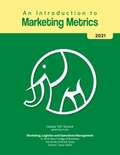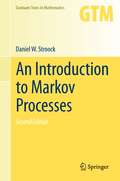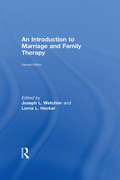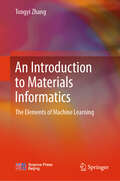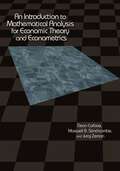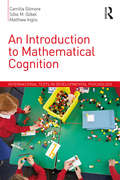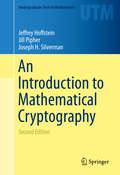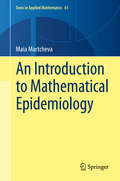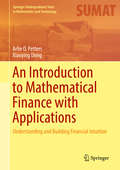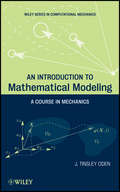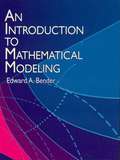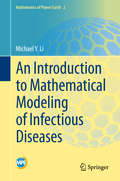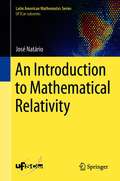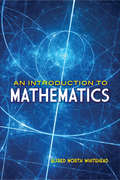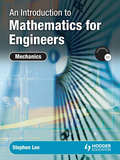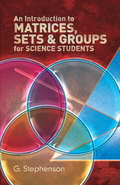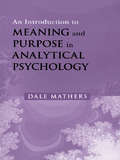- Table View
- List View
An Introduction to Marketing Metrics
by Gopala Gg" Ganesh“This book has resulted from a successful attempt to build the first undergraduate Marketing Metrics course in the world. To date, the course has been completed by more than 7,000 students- usually in traditional classroom settings and occasionally as an online class as well. Originally called Marketing Tools and Skills, the course was eventually renamed as Marketing and Money and then renamed again as Marketing Metrics (MM). This final name is the right one because metrics is the core topic of the course. I view MM as my magnum opus, my unique and hopefully long-lasting contribution to the marketing discipline.” – by the author.
An Introduction to Markov Processes (Graduate Texts in Mathematics #230)
by Daniel W. StroockThis book provides a rigorous but elementary introduction to the theory of Markov Processes on a countable state space. It should be accessible to students with a solid undergraduate background in mathematics, including students from engineering, economics, physics, and biology. Topics covered are: Doeblin's theory, general ergodic properties, and continuous time processes. Applications are dispersed throughout the book. In addition, a whole chapter is devoted to reversible processes and the use of their associated Dirichlet forms to estimate the rate of convergence to equilibrium. These results are then applied to the analysis of the Metropolis (a. k. a simulated annealing) algorithm. The corrected and enlarged 2nd edition contains a new chapter in which the author develops computational methods for Markov chains on a finite state space. Most intriguing is the section with a new technique for computing stationary measures, which is applied to derivations of Wilson's algorithm and Kirchoff's formula for spanning trees in a connected graph.
An Introduction to Markov State Models and Their Application to Long Timescale Molecular Simulation (Advances in Experimental Medicine and Biology #797)
by Gregory R. Bowman Vijay S. Pande Frank NoéThe aim of this book volume is to explain the importance of Markov state models to molecular simulation, how they work, and how they can be applied to a range of problems. The Markov state model (MSM) approach aims to address two key challenges of molecular simulation: 1) How to reach long timescales using short simulations of detailed molecular models. 2) How to systematically gain insight from the resulting sea of data. MSMs do this by providing a compact representation of the vast conformational space available to biomolecules by decomposing it into states sets of rapidly interconverting conformations and the rates of transitioning between states. This kinetic definition allows one to easily vary the temporal and spatial resolution of an MSM from high-resolution models capable of quantitative agreement with (or prediction of) experiment to low-resolution models that facilitate understanding. Additionally, MSMs facilitate the calculation of quantities that are difficult to obtain from more direct MD analyses, such as the ensemble of transition pathways. This book introduces the mathematical foundations of Markov models, how they can be used to analyze simulations and drive efficient simulations, and some of the insights these models have yielded in a variety of applications of molecular simulation.
An Introduction to Marriage and Family Therapy
by Joseph L. Wetchler Lorna L. HeckerNow in its second edition, this text introduces readers to the rich history and practice of Marriage and Family Therapy, with 32 professionals from across the US presenting their knowledge in their areas of expertise. This blend of approaches and styles gives this text a unique voice and makes it a comprehensive resource for graduate students taking their first course in Marriage and Family Therapy. The book is divided into three sections: Part 1 focuses on the components on which 21st century family therapy is based and summarizes the most recent changes made to not only therapeutic interventions, but to the very concept of "family." Part 2 presents an overview of the 7 major theoretical models of the field: structural, strategic, Milan, social constructionist, experiential, transgenerational, and cognitive-behavioral family therapy. Each chapter in this section * Focuses on the founder of the theory, its theoretical tenants, and its key techniques* Shows how the model focuses on diversity* Presents the research that supports the approach Part 3 addresses specific treatment areas that are common to marriage and family therapists, such as sex therapy, pre-marital therapy, research, and ethics and legal issues. As an introduction to the field of Marriage and Family Therapy, this volume stands above the rest. Not only will readers gain an understanding of the rich history of the field and its techniques, but they will also see a complete picture of the context in which families are embedded, such as gender, culture, spirituality, and sexual orientation. This knowledge is the key to understanding what differentiates Marriage and Family Therapy from individual psychotherapy. Glossaries, case studies, tables, figures, and appendices appear generously throughout the text to present this information and give students a thorough overview to prepare them for their professional lives.
An Introduction to Materials Informatics: The Elements of Machine Learning
by Tongyi ZhangThis textbook educates current and future materials workers, engineers, and researchers on Materials Informatics. Volume I serves as an introduction, merging AI, ML, materials science, and engineering. It covers essential topics and algorithms in 11 chapters, including Linear Regression, Neural Networks, and more. Suitable for diverse fields like materials science, physics, and chemistry, it enables quick and easy learning of Materials Informatics for readers without prior AI and ML knowledge.
An Introduction to Materials and Chemistry: Book 1 (Science for Conservators)
by Joyce H. TownsendThis new edition of An Introduction to Materials and Chemistry, book 1 in the updated Science for Conservators series, provides conservators and conservators-in-training with a very basic introduction to the language of chemistry and to the scientific approach. Drawing on 40 years of experience as a conservation scientist, Joyce H. Townsend takes readers through the elementary steps that will enable them to understand and investigate materials in historic objects, and those modern materials used to conserve them, in scientific terms. The book also introduces basic chemistry concepts. It provides worked examples and exercises throughout. This new edition has been significantly expanded and updated, with new material about health and safety, sustainability, and the trend to use greener materials, amongst other topics. The book also includes all-new illustrations, a list of further reading and is accompanied by a Companion Website, which features additional examples, illustrations and more. An Introduction to Materials and Chemistry assumes no previous scientific knowledge and will be essential reading for pre-program applicants to, and students already on, postgraduate conservation programs worldwide. It will also be useful to conservators who are looking to refresh their knowledge or to fill gaps in their training, and for those who trained in languages other than English, but now work in that language.
An Introduction to Mathematical Analysis for Economic Theory and Econometrics
by Juraj Zeman Dean Corbae Maxwell StinchcombeProviding an introduction to mathematical analysis as it applies to economic theory and econometrics, this book bridges the gap that has separated the teaching of basic mathematics for economics and the increasingly advanced mathematics demanded in economics research today. Dean Corbae, Maxwell B. Stinchcombe, and Juraj Zeman equip students with the knowledge of real and functional analysis and measure theory they need to read and do research in economic and econometric theory. Unlike other mathematics textbooks for economics, An Introduction to Mathematical Analysis for Economic Theory and Econometrics takes a unified approach to understanding basic and advanced spaces through the application of the Metric Completion Theorem. This is the concept by which, for example, the real numbers complete the rational numbers and measure spaces complete fields of measurable sets. Another of the book's unique features is its concentration on the mathematical foundations of econometrics. To illustrate difficult concepts, the authors use simple examples drawn from economic theory and econometrics. Accessible and rigorous, the book is self-contained, providing proofs of theorems and assuming only an undergraduate background in calculus and linear algebra. Begins with mathematical analysis and economic examples accessible to advanced undergraduates in order to build intuition for more complex analysis used by graduate students and researchers Takes a unified approach to understanding basic and advanced spaces of numbers through application of the Metric Completion Theorem Focuses on examples from econometrics to explain topics in measure theory
An Introduction to Mathematical Cognition (International Texts in Developmental Psychology)
by Camilla Gilmore Silke M. Göbel Matthew InglisThe last decade has seen a rapid growth in our understanding of the cognitive systems that underlie mathematical learning and performance, and an increased recognition of the importance of this topic. This book showcases international research on the most important cognitive issues that affect mathematical performance across a wide age range, from early childhood to adulthood. The book considers the foundational competencies of nonsymbolic and symbolic number processing before discussing arithmetic, conceptual understanding, individual differences and dyscalculia, algebra, number systems, reasoning and higher-level mathematics such as formal proof. Drawing on diverse methodology from behavioural experiments to brain imaging, each chapter discusses key theories and empirical findings and introduces key tasks used by researchers. The final chapter discusses challenges facing the future development of the field of mathematical cognition and reviews a set of open questions that mathematical cognition researchers should address to move the field forward. This book is ideal for undergraduate or graduate students of psychology, education, cognitive sciences, cognitive neuroscience and other academic and clinical audiences including mathematics educators and educational psychologists.
An Introduction to Mathematical Cryptography (Undergraduate Texts in Mathematics)
by Joseph H. Silverman Jeffrey Hoffstein Jill PipherThis self-contained introduction to modern cryptography emphasizes the mathematics behind the theory of public key cryptosystems and digital signature schemes. The book focuses on these key topics while developing the mathematical tools needed for the construction and security analysis of diverse cryptosystems. Only basic linear algebra is required of the reader; techniques from algebra, number theory, and probability are introduced and developed as required. This text provides an ideal introduction for mathematics and computer science students to the mathematical foundations of modern cryptography. The book includes an extensive bibliography and index; supplementary materials are available online. The book covers a variety of topics that are considered central to mathematical cryptography. Key topics include: classical cryptographic constructions, such as Diffie-Hellmann key exchange, discrete logarithm-based cryptosystems, the RSA cryptosystem, and digital signatures; fundamental mathematical tools for cryptography, including primality testing, factorization algorithms, probability theory, information theory, and collision algorithms; an in-depth treatment of important cryptographic innovations, such as elliptic curves, elliptic curve and pairing-based cryptography, lattices, lattice-based cryptography, and the NTRU cryptosystem. The second edition of An Introduction to Mathematical Cryptography includes a significant revision of the material on digital signatures, including an earlier introduction to RSA, Elgamal, and DSA signatures, and new material on lattice-based signatures and rejection sampling. Many sections have been rewritten or expanded for clarity, especially in the chapters on information theory, elliptic curves, and lattices, and the chapter of additional topics has been expanded to include sections on digital cash and homomorphic encryption. Numerous new exercises have been included.
An Introduction to Mathematical Epidemiology (Texts in Applied Mathematics #61)
by Maia MartchevaThe book is a comprehensive, self-contained introduction to the mathematical modeling and analysis of infectious diseases. It includes model building, fitting to data, local and global analysis techniques. Various types of deterministic dynamical models are considered: ordinary differential equation models, delay-differential equation models, difference equation models, age-structured PDE models and diffusion models. It includes various techniques for the computation of the basic reproduction number as well as approaches to the epidemiological interpretation of the reproduction number. MATLAB code is included to facilitate the data fitting and the simulation with age-structured models.
An Introduction to Mathematical Finance with Applications: Understanding and Building Financial Intuition (Springer Undergraduate Texts in Mathematics and Technology)
by Arlie O. Petters Xiaoying DongThis textbook aims to fill the gap between those that offer a theoretical treatment without many applications and those that present and apply formulas without appropriately deriving them. The balance achieved will give readers a fundamental understanding of key financial ideas and tools that form the basis for building realistic models, including those that may become proprietary. Numerous carefully chosen examples and exercises reinforce the student's conceptual understanding and facility with applications. The exercises are divided into conceptual, application-based, and theoretical problems, which probe the material deeper. The book is aimed toward advanced undergraduates and first-year graduate students who are new to finance or want a more rigorous treatment of the mathematical models used within. While no background in finance is assumed, prerequisite math courses include multivariable calculus, probability, and linear algebra. The authors introduce additional mathematical tools as needed. The entire textbook is appropriate for a single year-long course on introductory mathematical finance. The self-contained design of the text allows for instructor flexibility in topics courses and those focusing on financial derivatives. Moreover, the text is useful for mathematicians, physicists, and engineers who want to learn finance via an approach that builds their financial intuition and is explicit about model building, as well as business school students who want a treatment of finance that is deeper but not overly theoretical.
An Introduction to Mathematical Modeling
by J. Tinsley OdenA modern approach to mathematical modeling, featuring unique applications from the field of mechanics An Introduction to Mathematical Modeling: A Course in Mechanics is designed to survey the mathematical models that form the foundations of modern science and incorporates examples that illustrate how the most successful models arise from basic principles in modern and classical mathematical physics. Written by a world authority on mathematical theory and computational mechanics, the book presents an account of continuum mechanics, electromagnetic field theory, quantum mechanics, and statistical mechanics for readers with varied backgrounds in engineering, computer science, mathematics, and physics. The author streamlines a comprehensive understanding of the topic in three clearly organized sections: Nonlinear Continuum Mechanics introduces kinematics as well as force and stress in deformable bodies; mass and momentum; balance of linear and angular momentum; conservation of energy; and constitutive equations Electromagnetic Field Theory and Quantum Mechanics contains a brief account of electromagnetic wave theory and Maxwell's equations as well as an introductory account of quantum mechanics with related topics including ab initio methods and Spin and Pauli's principles Statistical Mechanics presents an introduction to statistical mechanics of systems in thermodynamic equilibrium as well as continuum mechanics, quantum mechanics, and molecular dynamics Each part of the book concludes with exercise sets that allow readers to test their understanding of the presented material. Key theorems and fundamental equations are highlighted throughout, and an extensive bibliography outlines resources for further study. Extensively class-tested to ensure an accessible presentation, An Introduction to Mathematical Modeling is an excellent book for courses on introductory mathematical modeling and statistical mechanics at the upper-undergraduate and graduate levels. The book also serves as a valuable reference for professionals working in the areas of modeling and simulation, physics, and computational engineering.
An Introduction to Mathematical Modeling (Dover Books on Computer Science)
by Edward A. BenderEmploying a practical, "learn by doing" approach, this first-rate text fosters the development of the skills beyond the pure mathematics needed to set up and manipulate mathematical models. The author draws on a diversity of fields -- including science, engineering, and operations research -- to provide over 100 reality-based examples. Students learn from the examples by applying mathematical methods to formulate, analyze, and criticize models. Extensive documentation, consisting of over 150 references, supplements the models, encouraging further research on models of particular interest. The lively and accessible text requires only minimal scientific background. Designed for senior college or beginning graduate-level students, it assumes only elementary calculus and basic probability theory for the first part, and ordinary differential equations and continuous probability for the second section. All problems require students to study and create models, encouraging their active participation rather than a mechanical approach. Beyond the classroom, this volume will prove interesting and rewarding to anyone concerned with the development of mathematical models or the application of modeling to problem solving in a wide array of applications.
An Introduction to Mathematical Modeling of Infectious Diseases (Mathematics of Planet Earth #2)
by Michael Y. LiThis text provides essential modeling skills and methodology for the study of infectious diseases through a one-semester modeling course or directed individual studies. The book includes mathematical descriptions of epidemiological concepts, and uses classic epidemic models to introduce different mathematical methods in model analysis. Matlab codes are also included for numerical implementations. It is primarily written for upper undergraduate and beginning graduate students in mathematical sciences who have an interest in mathematical modeling of infectious diseases. Although written in a rigorous mathematical manner, the style is not unfriendly to non-mathematicians.
An Introduction to Mathematical Population Dynamics: Along the trail of Volterra and Lotka (UNITEXT #79)
by Mimmo Iannelli Andrea PuglieseThis book is an introduction to mathematical biology for students with no experience in biology, but who have some mathematical background. The work is focused on population dynamics and ecology, following a tradition that goes back to Lotka and Volterra, and includes a part devoted to the spread of infectious diseases, a field where mathematical modeling is extremely popular. These themes are used as the area where to understand different types of mathematical modeling and the possible meaning of qualitative agreement of modeling with data. The book also includes a collections of problems designed to approach more advanced questions. This material has been used in the courses at the University of Trento, directed at students in their fourth year of studies in Mathematics. It can also be used as a reference as it provides up-to-date developments in several areas.
An Introduction to Mathematical Proofs (Textbooks in Mathematics)
by Nicholas A. LoehrAn Introduction to Mathematical Proofs presents fundamental material on logic, proof methods, set theory, number theory, relations, functions, cardinality, and the real number system. The text uses a methodical, detailed, and highly structured approach to proof techniques and related topics. No prerequisites are needed beyond high-school algebra. New material is presented in small chunks that are easy for beginners to digest. The author offers a friendly style without sacrificing mathematical rigor. Ideas are developed through motivating examples, precise definitions, carefully stated theorems, clear proofs, and a continual review of preceding topics. Features Study aids including section summaries and over 1100 exercises Careful coverage of individual proof-writing skills Proof annotations and structural outlines clarify tricky steps in proofs Thorough treatment of multiple quantifiers and their role in proofs Unified explanation of recursive definitions and induction proofs, with applications to greatest common divisors and prime factorizations About the Author: Nicholas A. Loehr is an associate professor of mathematics at Virginia Technical University. He has taught at College of William and Mary, United States Naval Academy, and University of Pennsylvania. He has won many teaching awards at three different schools. He has published over 50 journal articles. He also authored three other books for CRC Press, including Combinatorics, Second Edition, and Advanced Linear Algebra.
An Introduction to Mathematical Reasoning
by Peter J. EcclesThis book eases students into the rigors of university mathematics. The emphasis is on understanding and constructing proofs and writing clear mathematics. The author achieves this by exploring set theory, combinatorics, and number theory, topics that include many fundamental ideas and may not be a part of a young mathematician's toolkit. This material illustrates how familiar ideas can be formulated rigorously, provides examples demonstrating a wide range of basic methods of proof, and includes some of the all-time-great classic proofs. The book presents mathematics as a continually developing subject. Material meeting the needs of readers from a wide range of backgrounds is included. The over 250 problems include questions to interest and challenge the most able student but also plenty of routine exercises to help familiarize the reader with the basic ideas.
An Introduction to Mathematical Relativity (Latin American Mathematics Series)
by José NatárioThis concise textbook introduces the reader to advanced mathematical aspects of general relativity, covering topics like Penrose diagrams, causality theory, singularity theorems, the Cauchy problem for the Einstein equations, the positive mass theorem, and the laws of black hole thermodynamics. It emerged from lecture notes originally conceived for a one-semester course in Mathematical Relativity which has been taught at the Instituto Superior Técnico (University of Lisbon, Portugal) since 2010 to Masters and Doctorate students in Mathematics and Physics. Mostly self-contained, and mathematically rigorous, this book can be appealing to graduate students in Mathematics or Physics seeking specialization in general relativity, geometry or partial differential equations. Prerequisites include proficiency in differential geometry and the basic principles of relativity. Readers who are familiar with special relativity and have taken a course either in Riemannian geometry (for students of Mathematics) or in general relativity (for those in Physics) can benefit from this book.
An Introduction to Mathematical Taxonomy (Dover Books on Biology)
by B. S. Everitt G. DunnStudents of mathematical biology discover modern methods of taxonomy with this text, which introduces taxonomic characters, the measurement of similarity, and the analysis of principal components. Other topics include multidimensional scaling, cluster analysis, identification and assignment techniques, more. A familiarity with matrix algebra and elementary statistics are the sole prerequisites.
An Introduction to Mathematics (Dover Books on Mathematics)
by Alfred North Whitehead"The object of the following chapters is not to teach mathematics, but to enable students from the very beginning of their course to know what the science is about, and why it is necessarily the foundation of exact thought as applied to natural phenomena." Thus begins this volume by the prominent English philosopher and mathematician Alfred North Whitehead, a concise statement on the nature and meaning of mathematics for the general student. Expertly written and abounding in insights, the book presents a lively exposition of mathematical concepts, the history of their development, and their applications to the physical world. Whitehead explains in broad terms what mathematics is about, what it does, and how mathematicians do it.Generations of readers who have stayed with the philosopher from the beginning to the end have found themselves amply rewarded for taking this journey.
An Introduction to Mathematics for Economics
by Akihito AsanoAn Introduction to Mathematics for Economics introduces quantitative methods to students of economics and finance in a succinct and accessible style. The introductory nature of this textbook means a background in economics is not essential, as it aims to help students appreciate that learning mathematics is relevant to their overall understanding of the subject. Economic and financial applications are explained in detail before students learn how mathematics can be used, enabling students to learn how to put mathematics into practice. Starting with a revision of basic mathematical principles the second half of the book introduces calculus, emphasising economic applications throughout. Appendices on matrix algebra and difference/differential equations are included for the benefit of more advanced students. Other features, including worked examples and exercises, help to underpin the readers' knowledge and learning. Akihito Asano has drawn upon his own extensive teaching experience to create an unintimidating yet rigorous textbook.
An Introduction to Mathematics for Engineers: Mechanics
by Stephen LeeThis new introductory mechanics textbook is written for engineering students within further and higher education who are looking to bridge the gap between A-Level and university or college.
An Introduction to Matrices, Sets and Groups for Science Students
by G. StephensonThis outstanding text offers undergraduate students of physics, chemistry, and engineering a concise, readable introduction to matrices, sets, and groups. Concentrating mainly on matrix theory, the book is virtually self-contained, requiring a minimum of mathematical knowledge and providing all the background necessary to develop a thorough comprehension of the subject. Beginning with a chapter on sets, mappings, and transformations, the treatment advances to considerations of matrix algebra, inverse and related matrices, and systems of linear algebraic equations. Additional topics include eigenvalues and eigenvectors, diagonalisation and functions of matrices, and group theory. Each chapter contains a selection of worked examples and many problems with answers, enabling readers to test their understanding and ability to apply concepts.
An Introduction to Matrix Methods of Structural Analysis
by Muhammad Akram Tahir Worsak Kanok-NukulchaiThe matrix force method has been systematically developed for the analysis of beam and frame structures. It helps develop the matrix stiffness method from a basic spring element, and this is extended to the analysis of beams, trusses, plain frames, grillages, and space frames.Using computer programs (manual, automatic, or the direct force method extending toward automation), this book interactively introduces matrix methods of structural analysis. In addition to work and energy, it also discusses the concepts of stresses, strains, strain displacement relationship, and plain stress and strain. Features: Explains force, displacement, and stiffness via the matrix perspective. Reviews full programming code for each problem. Provides the modern concepts of force method that leads toward automation of the force method, such as the direct stiffness method. Discusses effect of temperatures exclusively. Includes the macro language Matrix Analysis Interpretive Language (MAIL) as an extension of analysis interpretive treatise with examples, exercises, PowerPoint slides, and illustrative problems. The MAIL executable, guide, and codes are provided on the website of the book. This book is aimed at senior undergraduate and postgraduate students in structural engineering.
An Introduction to Meaning and Purpose in Analytical Psychology
by Dale MathersThis highly original book examines the relationship between analytical psychology and meaning, interpreting human suffering as arising from meaning disorders. Using clinical examples - whether people trapped in patterns of dependence, suffering from psychosomatic diseases, or with personality problems - it shows how, by treating clients' issues as failures of the meaning-making process, one can help them change their own own personal meaning. An Introduction to Meaning and Purpose in Analytical Psychology will make provocative reading for all those in helping professions, including counsellors, psychotherapists, and psychiatrists.
